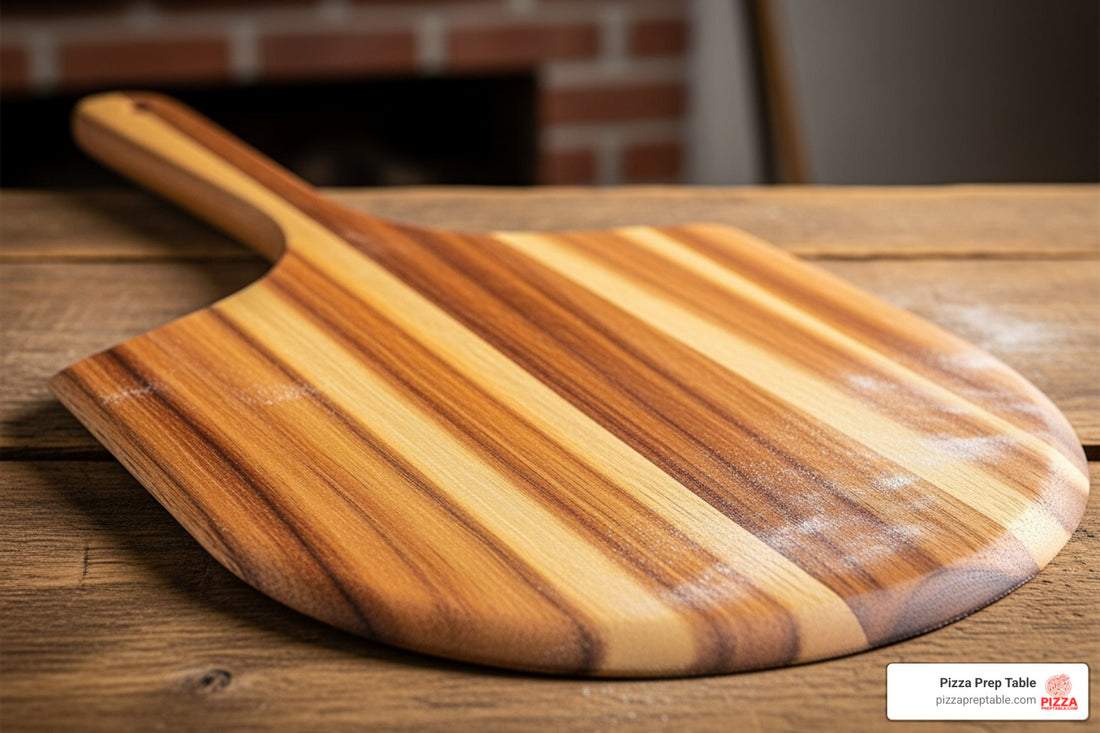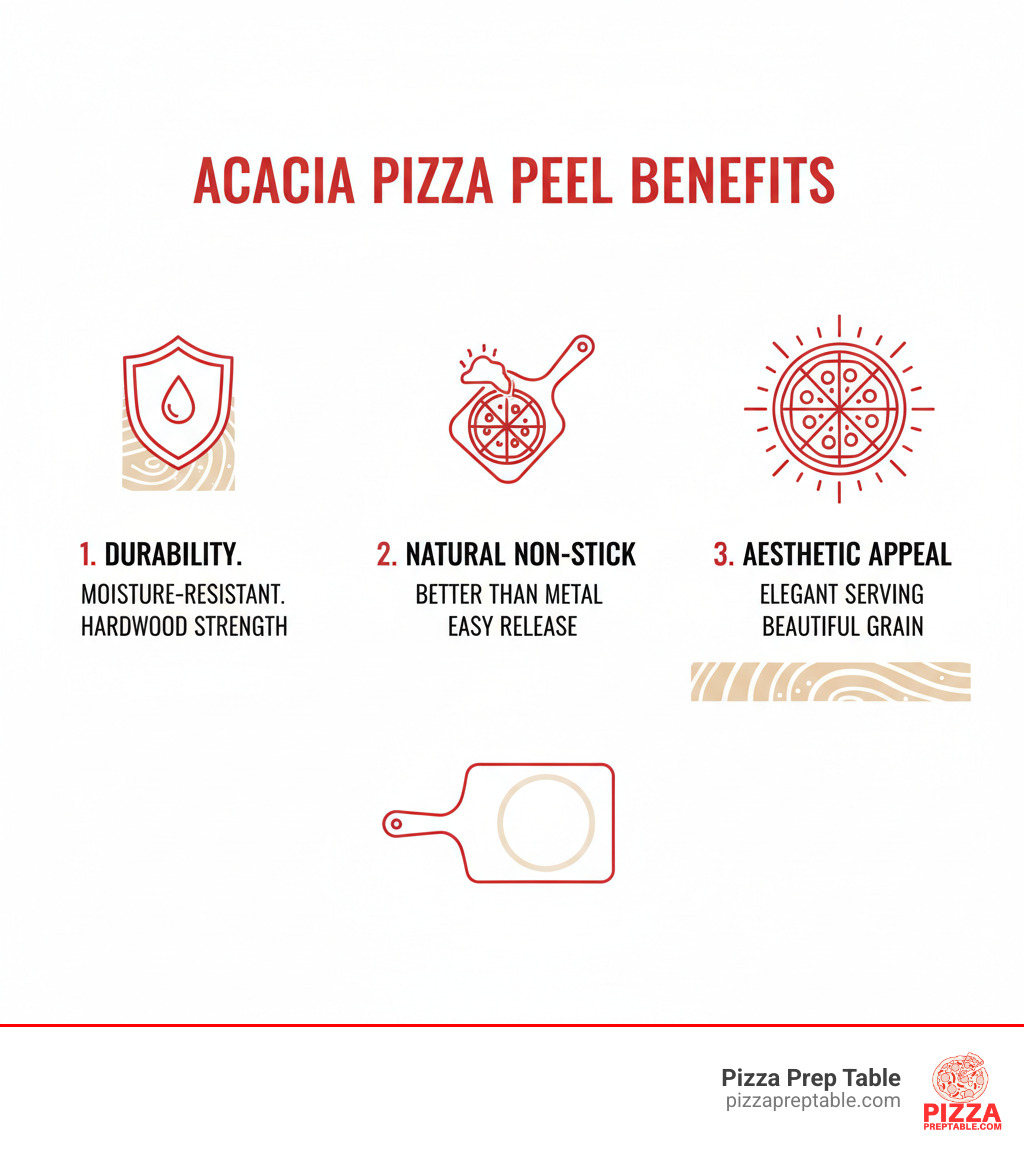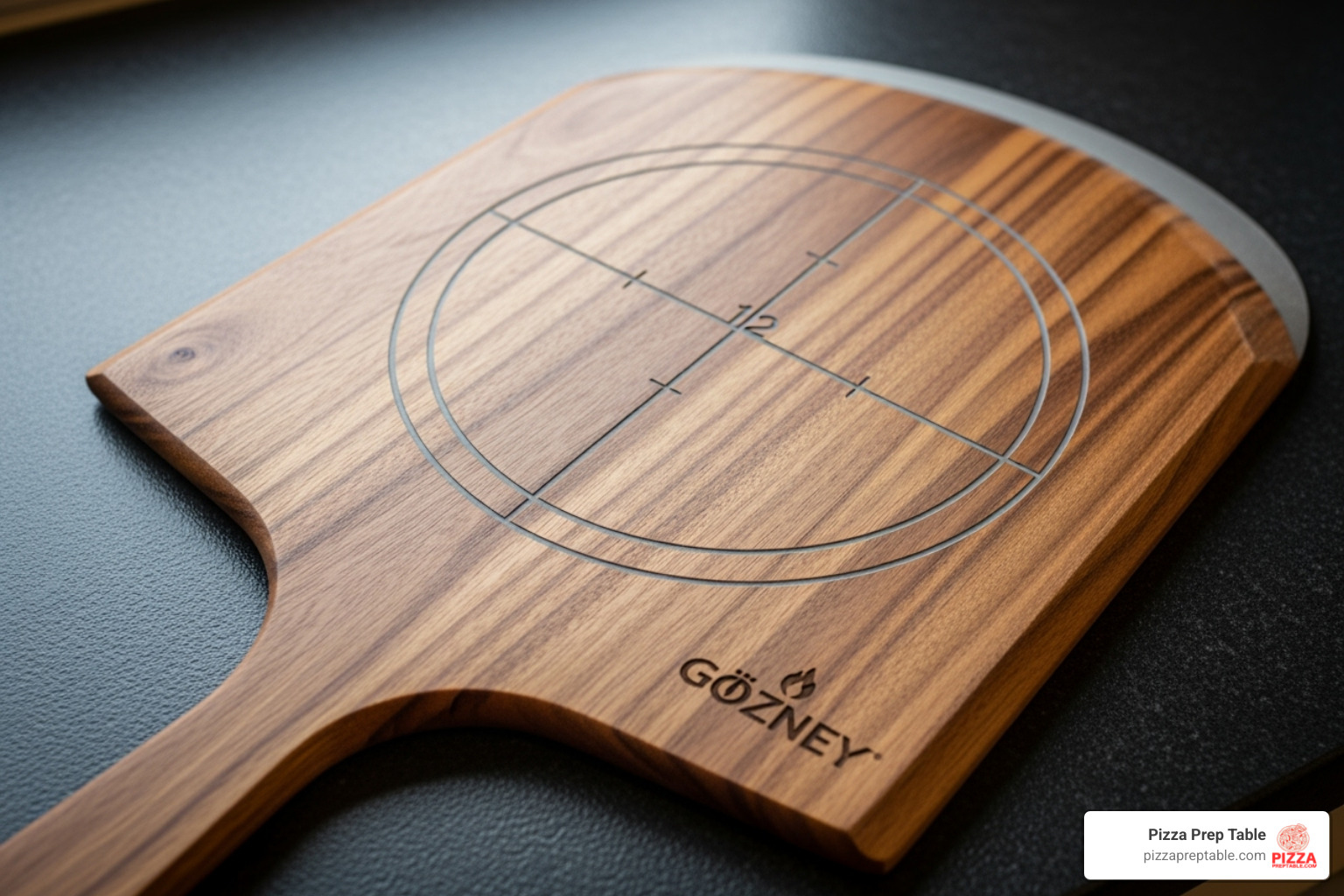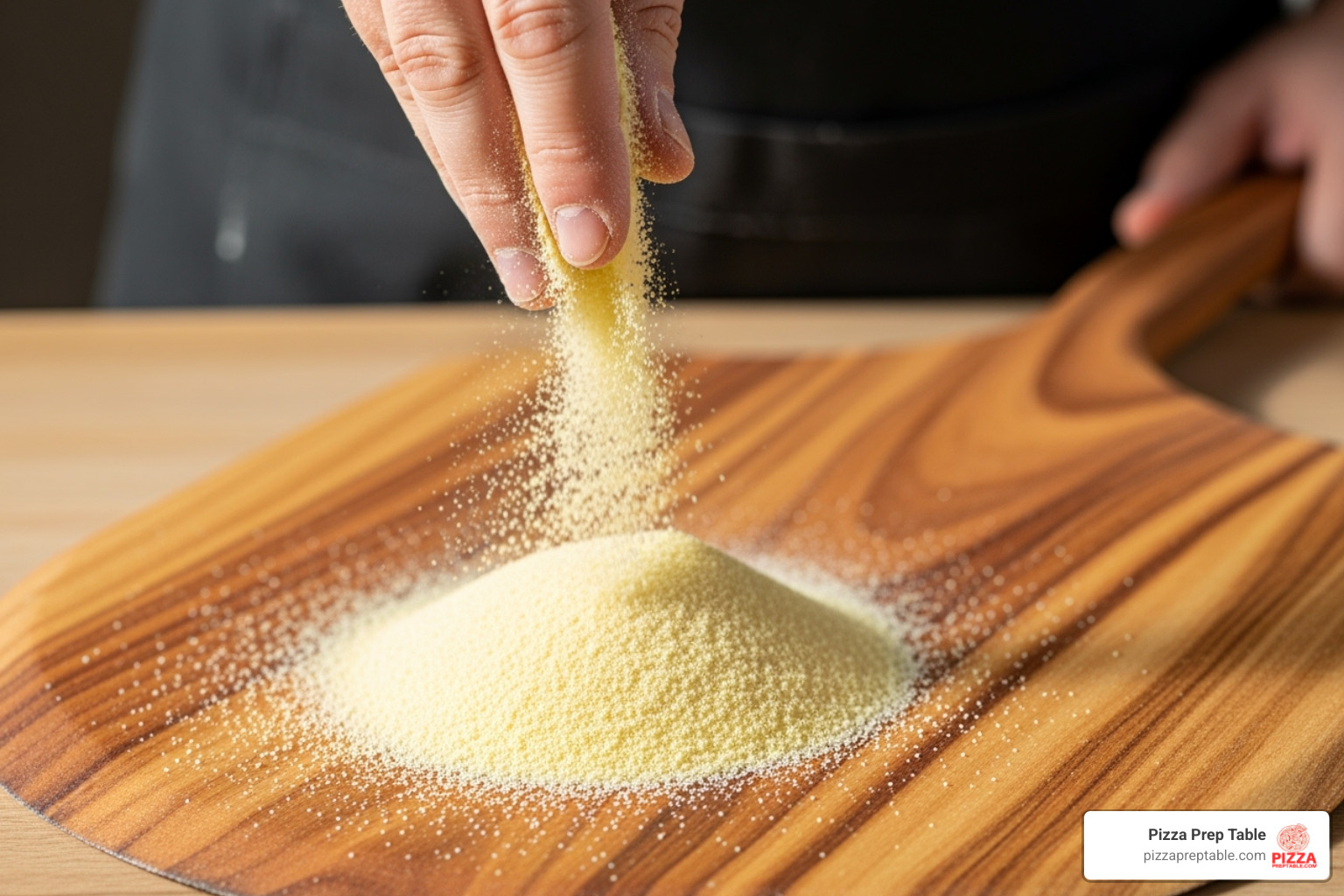
Slice, Serve, and Smile: Top Acacia Pizza Peels for Every Home Chef
Share
Why an Acacia Wood Pizza Peel is a Cut Above the Rest
An acacia pizza peel is a flat paddle made from acacia hardwood that helps you slide pizzas into and out of ovens safely. If you're new to the tool, see the overview of the peel (tool). Here's what makes acacia peels stand out:
- Naturally non-stick - Raw dough slides off easily with just a dusting of flour
- Incredibly durable - Acacia wood resists moisture and won't crack like softer woods
- Beautiful grain - Doubles as a neat serving board for entertaining
- Heat resistant - Won't warp or burn like cheaper wood alternatives
- Easy maintenance - Simple hand washing and occasional oiling keeps it in great shape
Acacia peels are truly the "pizza maker's best friend." Whether launching your first margherita or serving wood-fired masterpieces, the right peel prevents dough disasters. The secret lies in acacia's unique properties. This hardwood naturally prevents sticking better than metal peels, while being far more durable than pine or bamboo alternatives. Plus, its rich grain pattern means your peel looks stunning when serving pizzas at dinner parties.
My experience in restaurant equipment sales has shown me how the right tools transform a kitchen. I've seen why acacia pizza peels are the perfect blend of functionality and durability for both home chefs and commercial kitchens.

Why an Acacia Wood Pizza Peel is a Cut Above the Rest
When you're serious about making great pizza at home, your tools matter as much as your recipe. For pizza peels, acacia wood consistently outperforms the competition, changing your pizza-making experience.
Durability is where acacia truly shines. This hardwood is naturally tough and resistant to moisture, so your peel won't warp or crack. Unlike softer woods like pine, acacia handles daily wear and tear. Customers use their acacia peels for years—a worthy investment.
The aesthetic appeal of acacia wood is hard to beat. Each peel has unique wood grain patterns with rich, warm tones. This beauty isn't just for show. Your acacia pizza peel doubles as a stunning serving presentation board, letting you bring a gorgeous pizza from oven to table with style.
Let's talk about the natural non-stick surface. Dusted with flour, acacia wood creates a surface that lets dough slide off smoothly. Wood peels have a clear advantage over metal peels here. Raw dough tends to stick to metal, which can turn a perfect pizza into a crumpled mess.
Compared to other woods like pine and bamboo, the differences are clear. Pine is softer and prone to moisture damage. Bamboo can be less durable. Acacia strikes the perfect balance of strength, beauty, and functionality.
Whether you're starting out or leveling up, the right techniques make all the difference. Check out our guide on how to prep pizza like a pro for expert tips to help you make the most of your acacia peel.
Top Acacia Pizza Peels for Your Kitchen
Finding the perfect acacia pizza peel can transform your pizza-making experience. After testing countless peels and talking with home chefs, we've identified three standout options that deliver exceptional results.
Gozney Acacia Wood Pizza Peel & Server: The Pro's Choice
Among enthusiasts, the Gozney Acacia Wood Pizza Peel consistently tops the list. This beautifully crafted piece has earned its reputation as the pizza maker's best friend.

Its FSC-certified acacia construction means you're getting sustainably sourced hardwood built to last. The chamfered edge is key; this ultra-thin edge slides under dough easily, preventing tears. Seasoned pizza makers also love the etched pizza size guides on the surface, which help you achieve perfectly sized pizzas every time. It is available in 12-inch and 14-inch versions.
At 13mm thick, it balances sturdiness with a thin profile for easy maneuvering. The metal hanging loop keeps it within reach.
The Pampered Chef Pizza Peel: The Entertainer's Favorite
For those who love hosting, The Pampered Chef Pizza Peel is a favorite. With an impressive 4.8 out of 5 stars from 192 reviews and a 97% recommendation rate, this acacia wood peel has won over home chefs.
Its popularity lies in its clever design. The tapered edge makes sliding pizzas effortless, while the generous size (around 20½ x 14 inches) offers plenty of room. This peel also doubles as a stunning charcuterie board. Imagine serving a fresh pizza, then using the same board to present cheeses and cured meats. Your guests will be impressed, and you'll have one less dish to wash.
The hanging hole keeps it accessible and adds to your kitchen's aesthetic. At around $39.50, it offers incredible value.
Toscana Acacia Pizza Peel Serving Paddle: The All-in-One
The Toscana Acacia Pizza Peel Serving Paddle is a tool that gets everything right. With a perfect 5.0 out of 5 stars and a 100% recommendation rate, it's clear this peel is a hit with home cooks who demand function and beauty.
Measuring 22.75" x 14" x 0.6" and weighing 2.4 pounds, this peel feels substantial. The beveled edge slides smoothly, while the tapered handle provides a confident grip. It truly transforms your serving game, with users describing it as a "showpiece." The rich acacia grain makes every presentation special, and it fits up to a 14-inch pizza.
Customers use it for rolling pie crusts, serving bread, and presenting appetizers—it's a versatile kitchen tool. When you want one beautiful piece that handles multiple jobs, this is your answer.
How to Choose the Perfect Acacia Pizza Peel
Selecting the ideal acacia pizza peel is about matching its features to your needs, oven, and pizza-making style. Find a tool that makes your pizza journey joyful.
Consider the pizzas you make and the oven you use, as these factors influence the dimensions you'll need. This comparison table highlights key features:
| Feature | Description | Best Use |
|---|---|---|
| Peel Size (12", 14", 16") | The size of the pizza you typically make, and the width of your oven door. | 12-inch for traditional Neapolitan, 14-inch for larger home pies. |
| Edge Type (Beveled, Tapered, Blunt) | A thin edge (beveled or tapered) makes it easier to slide under dough. | Beveled/tapered edges are crucial for smooth pizza transfer. Avoid blunt edges. |
| Handle Design (Round, Flat, Tapered) | Comfort and grip are key for confident maneuvering. | Rounded or tapered handles offer better grip and comfort than flat or blocky ones. |
| Best Use (Launching, Serving, Small Ovens) | Consider if you need a dedicated launching peel, a serving board, or a versatile option for compact spaces. | Wooden peels are ideal for launching. Some acacia peels double as serving boards. Shorter handles are better for smaller ovens. |
Whether setting up a commercial kitchen or a backyard pizza paradise, these factors will help you choose a peel that performs beautifully. For those dreaming of an outdoor pizza haven, we have tips on how to build your perfect pizza station.
Decoding Dimensions for Your Acacia Pizza Peel
The dimensions of your acacia pizza peel are crucial. A peel that's too wide for your oven door or too long for your kitchen will be awkward. Measure your oven's opening and depth for a comfortable fit.
Next, think about your pizza size. A 12-inch peel is perfect for smaller, Neapolitan-style pizzas. For family-sized pies up to 14 inches, a 14-inch peel is a better fit. Always clarify the usable surface area, as it may differ from the stated width. Finally, consider the total length for storage—a long handle is great for deep ovens but can be cumbersome in a small kitchen.
Essential Features of a Quality Acacia Pizza Peel
Beyond dimensions, several features separate a great acacia pizza peel from an average one. A beveled or tapered edge is most critical. This thin, angled edge slides effortlessly under dough. A blunt edge will push the pizza around, leading to frustration.
A comfortable handle is also important. Rounded or tapered handles offer a better, more secure grip than flat designs, giving you confidence when transferring a hot pizza.
The thickness of your peel matters. A quality acacia peel (around 10-13mm thick) balances durability with a thin profile for easier sliding, though the edge should be much thinner.
Small details make a big difference. A hanging loop allows for easy storage and prevents damage. The shape also matters: square peels often provide more surface area than semi-circular ones, which can be helpful for stretching and topping dough directly on the peel.
Best Practices for Using and Maintaining Your Peel
Knowing how to use and care for your acacia pizza peel will make it a trusted companion for years.

Using Your Peel: From Prep to Plate
The key to success is preventing sticking. Properly prep your acacia pizza peel to launch your pizza smoothly.
Semolina flour is your secret weapon. This coarse flour acts like tiny ball bearings, letting dough glide effortlessly. Sprinkle it generously. Cornmeal also works but can add a crunch to the crust.
Once your dough is on the peel, work quickly. Moisture from the dough can create a sticky situation. Have your oven hot and ready before assembling your pizza.
For launching like a pro, use a quick, smooth forward motion with a flick of your wrist. The pizza should roll off the peel. With practice, you'll be launching pizzas with confidence.
Retrieving your masterpiece is just as important. Slide the beveled edge under the cooked pizza in one smooth motion. The peel's natural non-stick properties make this easy.
A crucial safety tip: never use parchment paper for launching into a very hot oven, as it can burn. Trust your floured acacia pizza peel instead. For more insights on essential pizza prep tools, check out our guide on Cutting Edge Choices: Best Pizza Prep Table Cutting Boards.
Care and Maintenance for Longevity
Your acacia pizza peel needs some TLC. Caring for it is straightforward and takes only a few minutes.
Cleaning should be gentle. Wipe the peel with a damp cloth to remove residue. Never submerge your peel in water or put it in the dishwasher, as this leads to warping and cracking.
Skip harsh scrubbers. For stubborn spots, use warm water and a soft cloth. For proper drying and storage, let it air dry completely before storing. Use a hanging loop if available to allow air circulation. Store it in a dry place away from extreme temperatures.
Conditioning the wood is like a monthly spa treatment. Rub it with food-safe mineral oil to prevent drying and improve its non-stick properties.
For common issues, don't panic. Slight warping can happen; try placing it warp-side up on a flat surface overnight. Small scratches are normal, but avoid cutting on the peel to prevent grooves that harbor bacteria. For stubborn odors, scrub the surface with a lemon half dipped in coarse salt, then wipe clean.
With this routine, your acacia pizza peel will age beautifully, developing a rich patina and becoming even more non-stick over time.
Frequently Asked Questions about Acacia Pizza Peels
Choosing the right tools can be confusing. Let's clear up common questions about acacia pizza peels to get you confidently crafting perfect pizzas.
Is an acacia wood or metal peel better for making pizza?
This is a common question. Both wood and metal peels are great tools for different situations.
Acacia wood peels are fantastic for launching raw pizza dough. The porous surface, when dusted with flour, creates a non-stick platform that lets dough slide off easily. Wood offers great control, reducing the risk of mishaps.
Metal peels, on the other hand, are workhorses for retrieving and turning pizzas. Their thin edges slip under a finished pizza easily. Perforated metal peels also let excess flour fall away.
For most home chefs, an acacia pizza peel is the most versatile option. It handles launching, works for retrieval, and doubles as a serving board. While pros often use both, acacia is the best all-in-one choice for a home kitchen.
Can I cut my pizza directly on my acacia pizza peel?
While tempting, you should not cut pizza directly on your acacia pizza peel. Cutting creates grooves in the wood, which can make the surface grippier and cause future dough to stick. These grooves can also harbor bacteria.
Cutting on hard acacia wood will also dull your knife blade. The simple solution is to slide your pizza onto a separate cutting board before slicing. This keeps your peel smooth and your knife sharp.
How do I stop my pizza dough from sticking to the peel?
A stuck pizza is a common problem, but it's fixable. The secret is semolina flour. This coarse flour acts like tiny ball bearings, letting your dough glide. Dust your acacia pizza peel generously.
Your dough consistency also matters. A sticky, wet dough will cling regardless of flour. Ensure your dough is the right consistency first.
Finally, speed matters. Once dough is on the peel, you're on the clock. The longer it sits, the more moisture it releases, causing it to stick. Have your oven hot and ready before you assemble. A quick, confident forward motion is all you need to launch the pizza.
Conclusion: Lift Your Pizza Game
This guide has shown why an acacia pizza peel is the pizza maker's best friend. Its durability, moisture resistance, and beautiful grain offer everything a serious home chef needs, combining functionality with natural beauty.
We've explored great options like the pro-grade Gozney, the versatile Pampered Chef peel, and the neat Toscana serving paddle. Each highlights acacia's core benefits.
The right acacia pizza peel is your gateway to perfect pizza launches and stress-free entertaining. The natural non-stick properties and sturdy construction of acacia give you the confidence to create restaurant-quality results at home.
The best peel needs the right technique. Simple practices like semolina dusting, quick assembly, and proper care will keep your peel performing for years. It's an investment that pays dividends in every successful pizza night.
At PizzaPrepTable.com, we share your passion for perfect pizza. While we specialize in commercial pizza prep tables and restaurant equipment for foodservice businesses in cities like New York City, Los Angeles, and Chicago, we celebrate the craft wherever it happens.
Whether upgrading your home setup or running a pizzeria, the right tools make all the difference. Ready to lift your pizza game? Explore all the essential pizza oven supplies for perfect pies and find what you need to create memorable dining experiences.

